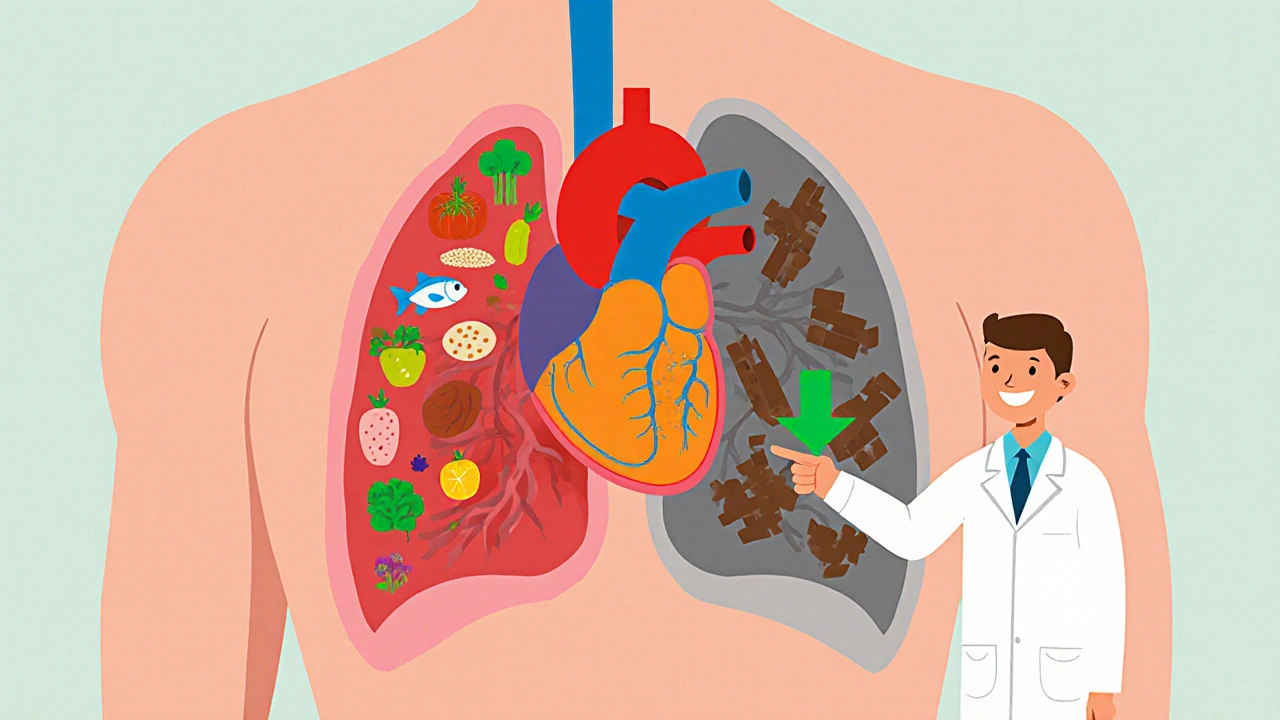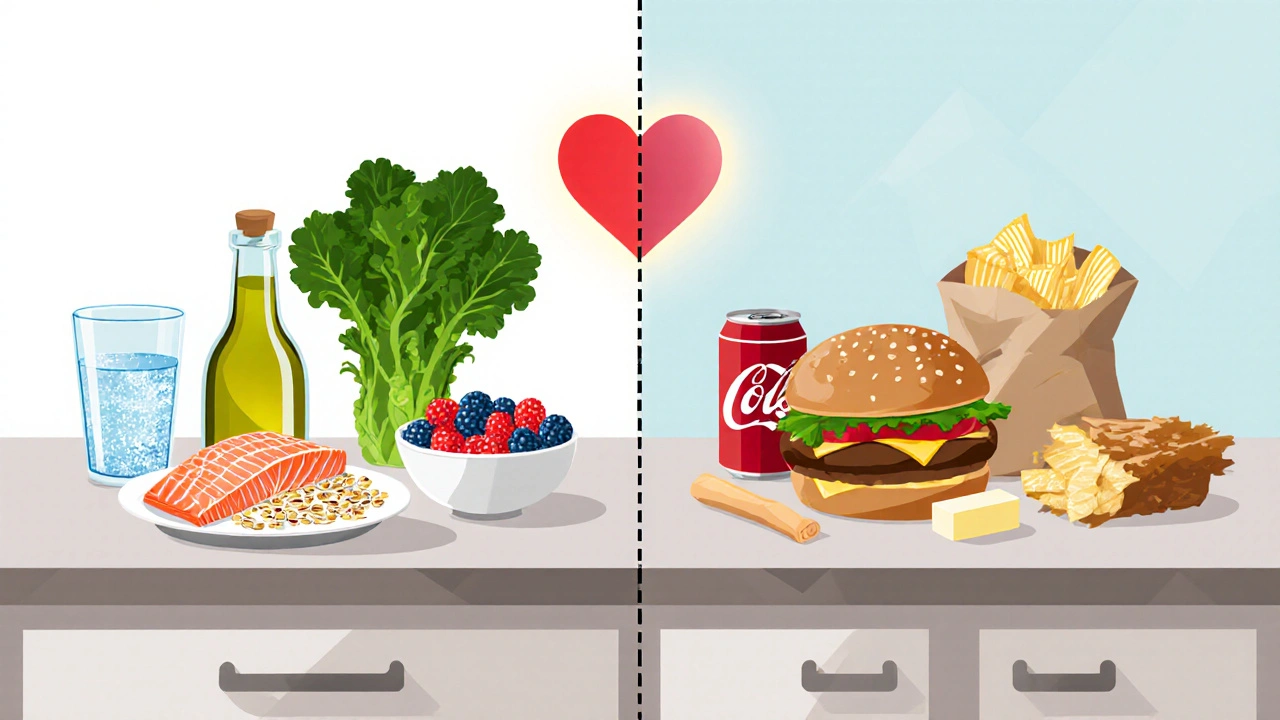Heart-Healthy Diet: Best Foods to Eat & Avoid for CAD Prevention
 Oct, 18 2025
Oct, 18 2025
When it comes to keeping your arteries clear, Coronary artery disease is a condition where plaque builds up inside the heart’s blood vessels, restricting blood flow and raising the risk of heart attacks. The good news? What you put on your plate can dramatically slow-or even reverse-this process. Below is a no‑fluff guide that shows exactly which foods help protect your heart and which ones you should push to the back of the fridge.
Why Your Diet Beats Medication for Early Prevention
Before you start counting calories, understand the biology. Plaque forms when low‑density lipoprotein (LDL) cholesterol, saturated fats, and inflammation stick to the inner wall of arteries. Over time, the buildup narrows the passageway, leading to chest pain or a heart attack. Eating the right foods lowers LDL, raises high‑density lipoprotein (HDL), and calms inflammation.
Studies from the American Heart Association (2024) show that people who follow a heart-healthy diet reduce their CAD risk by up to 30% compared to those who eat a typical Western diet. The key is consistency-not a quick‑fix diet.
Core Principles of a Heart‑Healthy Diet
- Fill half your plate with colorful vegetables and fruits.
- Choose whole grains over refined carbs.
- Prioritize lean proteins like fish, legumes, and skin‑less poultry.
- Swap saturated and trans fats for monounsaturated and polyunsaturated fats.
- Limit sodium to under 1,500 mg per day.
These rules are the backbone of two evidence‑based eating patterns: the Mediterranean diet and the DASH diet. Both have strong data linking them to lower coronary events.
Foods to Eat: Heart‑Boosting Heroes
Here’s a quick look at the star players you want on your grocery list.
- Omega‑3 fatty acids (salmon, sardines, chia seeds) - cut triglycerides and lower blood pressure.
- Fiber (oats, beans, berries) - binds cholesterol in the gut and speeds its removal.
- Leafy greens (spinach, kale) - rich in potassium, magnesium, and antioxidants.
- Whole grains (brown rice, quinoa, whole‑wheat bread) - provide steady energy without spiking blood sugar.
- Plant sterols (fortified spreads, nuts) - block cholesterol absorption.
- Low‑fat dairy (skim milk, yogurt) - source of calcium and vitamin D without excess saturated fat.
Mix and match these foods throughout the day. A bowl of oatmeal topped with berries and a spoonful of ground flax makes a perfect breakfast.

Foods to Avoid: Hidden Heart Saboteurs
Even small amounts of the wrong ingredients can undo your good work. Keep an eye out for these culprits.
- Saturated fat (fatty cuts of red meat, butter, full‑fat cheese) - raises LDL levels.
- Trans fat (partially hydrogenated oils in many processed snacks) - spikes inflammation and bad cholesterol.
- Sodium (canned soups, salty snacks, soy sauce) - drives up blood pressure.
- Sugar‑sweetened beverages and desserts - cause insulin spikes that can promote plaque formation.
- Refined carbs (white bread, pastries) - lack fiber and can raise triglycerides.
When you read labels, look for “0 g trans fat” and “less than 5 % of the daily value for saturated fat.” If a product isn’t listed, it likely contains hidden additives.
Side‑by‑Side Comparison
| Category | Examples (Eat) | Examples (Avoid) |
|---|---|---|
| Fats | Olive oil, avocado, nuts | Butter, lard, palm oil |
| Proteins | Salmon, beans, skin‑less chicken | Fatty beef, processed sausage |
| Carbohydrates | Whole‑grain bread, quinoa, sweet potatoes | White rice, sugary cereals, pastries |
| Snacks | Fresh fruit, hummus with veggie sticks | Chips, candy bars, baked goods with trans fat |
| Beverages | Water, green tea, unsweetened almond milk | Soda, energy drinks, sweetened coffee drinks |
Sample Day of Heart‑Smart Eating
- Breakfast: Overnight oats made with skim milk, topped with blueberries, a drizzle of honey, and a tablespoon of chia seeds.
- Mid‑morning snack: A small handful of almonds and an apple.
- Lunch: Quinoa salad with chickpeas, cherry tomatoes, cucumber, feta (low‑fat), and a lemon‑olive‑oil dressing.
- Afternoon snack: Carrot sticks with hummus.
- Dinner: Grilled salmon (rich in omega‑3) with a side of steamed broccoli and sweet potato mash.
- Evening treat: A cup of plain Greek yogurt with a sprinkle of cinnamon.
This plan hits all the heart‑healthy targets: plenty of fiber, lean protein, healthy fats, and low sodium.

Practical Tips to Stay on Track
- Shop the perimeter: Fresh produce, fish, and dairy are usually along the store’s outer edge, away from processed junk.
- Read labels: Look for “no added salt,” “0 g trans fat,” and “high in fiber.”
- Prep ahead: Cook a big batch of brown rice or beans on Sunday; they’re ready for quick meals all week.
- Mind the restaurant menu: Choose grilled, baked, or steamed options; ask for sauces on the side.
- Use spices, not salt: Garlic, rosemary, turmeric, and lemon add flavor without the sodium hit.
Even small changes, like swapping butter for olive oil or soda for sparkling water, add up over months.
Quick Takeaways
- Eat plenty of omega‑3s, fiber, leafy greens, whole grains, and plant sterols.
- Avoid saturated and trans fats, excess sodium, refined carbs, and sugary drinks.
- Adopt Mediterranean or DASH‑style eating patterns for proven heart protection.
- Plan meals, read labels, and use herbs for flavor to make the diet sustainable.
Frequently Asked Questions
Can a heart‑healthy diet reverse existing plaque?
While diet alone rarely removes large plaques, studies show that a strict Mediterranean or DASH regimen can stabilize plaque, improve arterial function, and even shrink small fatty streaks over 1‑2 years.
Do I need to count calories on a heart‑healthy diet?
Calorie counting isn’t mandatory; focus on nutrient density. If weight loss is a goal, a modest deficit (500 kcal/day) works well together with the food choices listed above.
Is it safe to eat fruit every day?
Yes. Whole fruits provide fiber, potassium, and antioxidants without the added sugars found in juices. Aim for 2‑3 servings daily.
How much sodium is too much?
The American Heart Association recommends under 1,500 mg per day for heart‑healthy adults. A single fast‑food meal can exceed that limit, so watch processed foods.
Can I still enjoy occasional treats?
Absolutely. The key is moderation. A small piece of dark chocolate (70% cacao) or a weekend pizza with a whole‑grain crust fits within a balanced plan.

Brian Van Horne
October 18, 2025 AT 20:31Your exposition delineates the salutary merits of omega‑3 rich comestibles with commendable precision. The recommendation to substitute saturated fats with monounsaturated alternatives is both prudent and efficacious.
Norman Adams
October 31, 2025 AT 13:04Ah, because we all have the time and culinary sophistication to orchestrate quinoa‑infused symphonies at breakfast, right? If only the aristocracy of dietetics could hear this, they'd surely faint.
Margaret pope
November 13, 2025 AT 06:37Everyone can start small and add a handful of berries to their morning oats it’s a simple way to boost fiber and antioxidants.
James Mali
November 26, 2025 AT 00:11One might argue that the pursuit of a heart‑healthy diet mirrors the futility of chasing a mirage; effort yields modest change yet the path remains worth treading.
Matthew Miller
December 8, 2025 AT 17:44Yo! Crush those cravings by swapping soda for sparkling water and feel the surge of vitality-your heart will thank you! Keep the momentum going and watch the pounds melt away as you fuel your engine with wholesome foods.